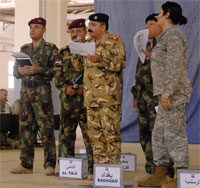mission: possible

At a U.S. military outpost some 60 miles northwest of Baghdad, the U.S. Army's First Sustainment Brigade is engaged in a little-publicized but crucially important part of the program to bring U.S. forces home from Iraq.
The brigade has the job of helping the Iraqi Army develop something it currently lacks—a logistics capability.
Before they can safely exit, the coalition forces must ensure that they're leaving behind a self-reliant Iraqi Security Force—one with a solid grasp of military logistics. The First's mission is to provide support for that effort and an umbrella while the instruction is under way, and it has less than three years to pull it off. Now that's a training challenge!
The First is located at Camp Taji, a former base for the Republican Guard. It has a complement of 85 soldiers divided into four Logistics Training and Advisory Teams that work with Iraqi units of some 1,200 men.
The teams partner with Iraq's Taji Location Command and General Transportation Regiment (GTR), which is at the center of the emerging logistics capability. Since Sept. 1, the GTR has had the responsibility of distributing all classes of supplies to location commands positioned throughout Iraq as well as maintenance facilities at Taji and Rustamiyah in eastern Baghdad.
Capt. Audrey Iriberri was one of the soldiers at the heart of the effort. The Manhattan native and 2005 graduate of the U.S. Military Academy at West Point served as deputy commander of one of the First Brigade's advisory teams and worked with the command staff of the Iraqi Army's Taji Location Command before returning home late last year.
Speaking to DC VELOCITY while still deployed in Iraq, Iriberri said that to be successful, the American advisers have to understand the way the Iraqi Army works. "Iraqi Army logistics is very centralized on the leaders," she explained. "All of their supply, maintenance, and transportation orders come from the top, from the Ministry of Defense." She described the Iraqi soldiers the First mentors as a group with a very diverse mix of experience—ranging from veteran officers to brand-new privates.
According to Iriberri, providing advice in this context requires flexibility. "It is a little bit of adopting some of the new techniques that they have seen used in coalition logistics and also using some of the doctrine that they have established in their old army."
The challenge, she added, is learning the Iraqi approach, accepting it for what it is, and resisting the impulse "to impose what we believe is right and what works in our army [on the Iraqis]." The goal, she emphasized, is to "make them stress their own system and find their own solution—an Iraqi solution to an Iraqi problem."
Iriberri was optimistic about the prospects for success. "The Iraqi Army has put its best foot forward in trying to re-create its logistics system," she said. "[For example,] the Taji third-line maintenance facility commander has been in the maintenance field his entire career, over 20 years, and the same with the transportation officers."
Training from the back seat
Capt. Iriberri's task was often a delicate one. She was a junior
captain who dealt with Iraqi colonels and generals, which required more than a little tact and
diplomacy.
Asked about a typical day, Capt. Iriberri said her workday frequently began with a visit to General Sabah, with an interpreter in tow. "General Sabah would insist on having chai [tea]," she said. "We would have tea and I would ask, 'When is the GTR arriving on Taji? Is the GTR arriving on Taji? How many people are coming with them, and how many vehicles are coming with them? Do they have a place to live? Does that place have beds? Does that place have power? How will they eat?' So a lot of it was just figuring out life support for the unit."
Her goal, she said, was to find out "to what extent that commander had doctrine already set in his mind and [come up with] a standard operating procedure for his unit to figure out what kind of training support we would be required to provide." Using the information she gleaned from her discussions with the general, Iriberri would determine whether the advisory team needed to provide technical assistance in establishing procedures from scratch, or if the team needed to learn an Iraqi system so it could identify areas for support. Training could then be precisely targeted to specific tasks, such as hand and arm signals for safety or appropriate tie-downs on vehicles to prevent rollovers.
Often, her role included gaining the confidence of Iraqi officers. "I could tell how a situation was going to go because every time I was introduced to an Iraqi officer, I extended my hand," she said. "There were times when they didn't take it, and that is fine. I just knew how it was going to go. It didn't change how I dealt with them as an American officer, so I would continue with what I had to say, what my business was, what command I represented, and what kind of support we would be able to provide. At the end of the conversation, I would always extend my hand again and never in the time I was there did the conversation end without a handshake."
Putting U.S. mentors out of a job
Each meeting can be seen as a small step toward the larger goal of ensuring that the GTR is prepared
to handle critical army logistics on its own when the U.S. forces inevitably depart.
In that same press release, a commander of the GTR, a colonel who goes by the single name Muhammad, added, "We will transport supplies, vehicle parts from the border of Jordan, Syria, and Kuwait or any border to the depot here on Taji for distribution to Iraqi Army location commands. The mission is to improve the movement of supplies, parts, and troops needed to help sustain the soldiers of the Iraqi Army."
Asked about the progress to date, Iriberri sounded like a proud parent, describing the GTR as "genuinely self-reliant in executing certain tasks. They receive their missions from the Ministry of Defense. They go outside the wire with their own convoy security elements. They execute and return without incident. So, in terms of the missions they have received so far, they are doing well without coalition support outside the wire.
"So many times you hear that the Iraqi Army is not ready to execute things on its own. But there is success. The GTR is the first and only unit of its kind—completely Iraqi run. We are not physically with them when they go outside the wire, but they have so far accomplished all of their missions. So it is a very good news story."
Reflecting on her time in Iraq, Iriberri said, "I just want to let you know and let people know that the Iraqi security forces are trying to better themselves and make it so that the Americans are working themselves out of a job. We would like it so that we could train the Iraqi Army and make it so that their system works for them their way. That is it."
Related Articles

Copyright ©2024. All Rights ReservedDesign, CMS, Hosting & Web Development :: ePublishing